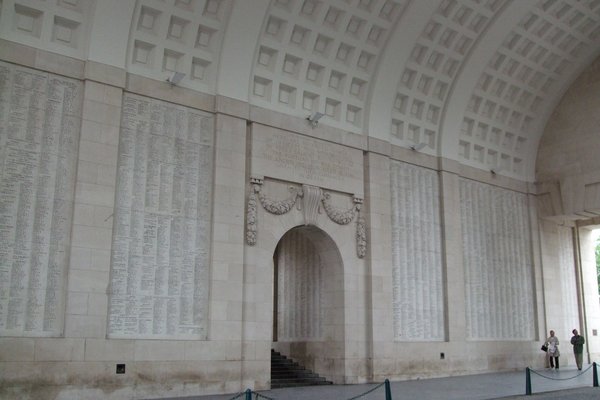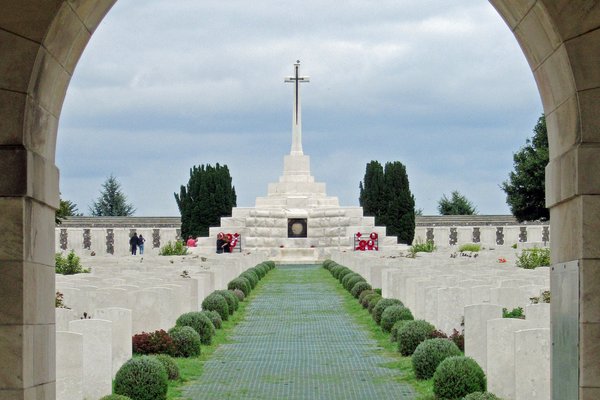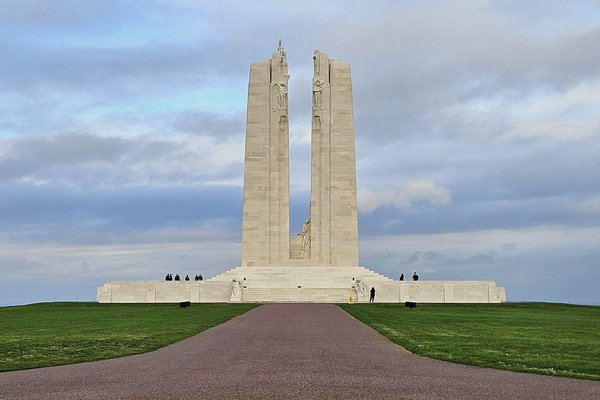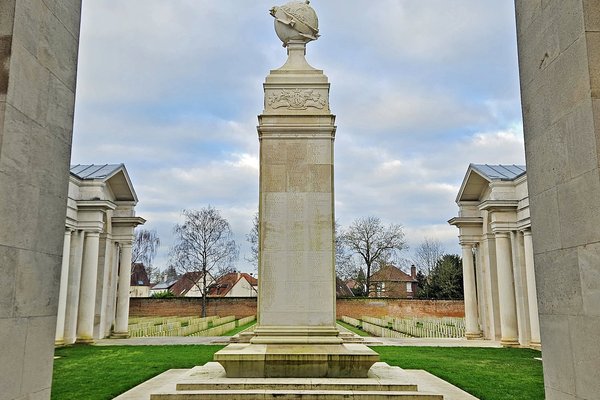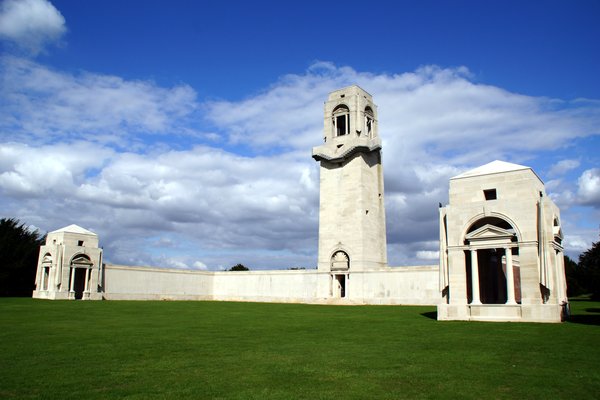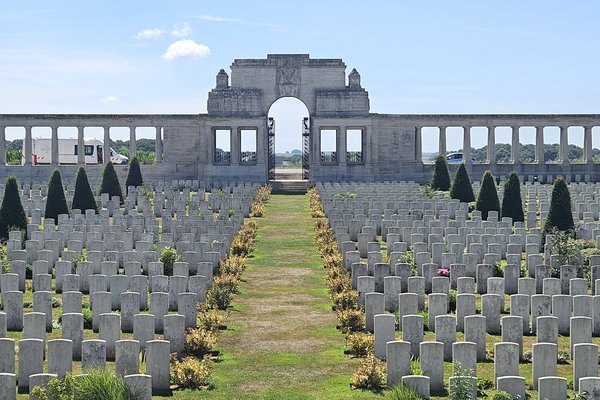Belgium, France
Funerary and memory sites of the First World War
The Funerary and memory sites of the First World War (Western Front) testify to the unprecedented scale of a global war and mark the start of a new tradition of remembering the war dead.
After this war, for the first time, the individual victim was remembered. This resulted in military cemeteries and war memorials of diverse typologies where attention was paid to aesthetics. These sites still are visited by millions.
Community Perspective: The sites comprise 139 locations in Belgium and northern France. Notable is that the"commemoration of all victims is equal irrespective of nation, race, creed or military rank, the graves and engravings of names are uniform". Especially recommended to visit is the area around Verdun, which "is basically one whole cultural/memorial landscape shaped by World War I".
Site Info
Official Information
- Full Name
- Funerary and memory sites of the First World War (Western Front) (ID: 1567)
- Status
-
Inscribed 2023
Site history
History of Funerary and memory sites of the First World War
- 2023: Advisory Body overruled
- ICOMOS advised Referral, mostly for the selection of sites.
- 2023: Inscribed
- Inscribed
- 2018: Adjourned
- Decision adjourned by WHC for 2 years
- 2014: Revision
- Includes and replaces "Le Westhoek, lieu de mémoire et monuments de la Grande Guerre" (on Belgian T List since 2002)
- Type
- Cultural
- Criteria
- iii
- iv
- vi
Links
- UNESCO
- whc.unesco.org
All Links
UNESCO.org
- whc.unesco.org — whc.unesco.org/
Community Information
- Community Category
- Human activity: Sites of Memory
Travel Information
Serial Transnational Sites
Brussels hotspot
Recent Connections
-
Works by Nobel Prize winning authors
Rudyard Kipling (1907), The King's Pilg… -
Brussels hotspot
Many of the Belgian locations are cente… -
Built in the 20th century
"The reburial in individual graves with…
Connections of Funerary and memory sites of the First World War
- Geography
-
-
Linear inscriptions
Along the Western Front of WWI
-
- Trivia
-
-
Built or owned by Portuguese
PC02 Portuguese Military Cemetery of Richebourg-l’Avoué -
Viewable from another WHS
You can see the "Mémorial national canadien « Vimy Memorial »" (part of the Funerary and memory sites of the First World War) from the slag heap of Pinchonvalles (Nord-Pas de Calais Mining Basin) & Citadelle d'Arras (Fortifications of Vauban) can be seen from the adjacent Faubourg d'Amiens Cemetery (Funerary and memory sites of the First World War). -
Serial sites with the greatest number of locations
135 -
Built or owned by Germans
"The German landscape architect Robert Tischer inspired the main principles for the arrangement of the German necropolises with the aim of preserving the sombre character of the cemeteries." and "The series includes 22 German-type cemeteries" (AB ev) -
Built or owned by Americans
"The American model was developed by the American Battle Monuments Commission (ABMC), created in 1923, inspired by the French architect Paul Philippe Cret, who emigrated to the United States in 1903" (AB ev) -
Built or owned by British
"After the war, several architects were called upon to rearrange the burial grounds already in existence since the war, according to models defined by four main architects: Reginald Blomfield, Edwin Lutyens, Herbert Baker and Charles Holden." and "Overall, the landscaping of Commonwealth cemeteries follows the English garden tradition, with different textures, colours, and densities." - 48 cemeteries (AB ev) -
Built or owned by Poles
MA04 National French Necropolis, Military German Cemetery and Military Polish Cemetery – it is noted that the Polish burials date back to the Second World War (AB ev) -
Built or Owned by Chinese
SE10 Commonwealth Military Cemetery “Noyelles-sur-Mer Chinese Cemetery” and Chinese memorial “Noyelles-sur-Mer Chinese Memorial
-
- History
-
-
Sieges and Battles
"The component sites include different types of necropolises – military, battlefield burial grounds,.." (AB ev), for example MA01 French Memorial of the Battles of the Marne -
Historical Events
"All along the Western Front of the First World War, (...) a series of 139 funerary and memorial sites bear witness to the common desire of the various parties involved in the conflict to honour their children who fell in battle." (Official description)
-
- Architecture
-
-
Neoclassical architecture
Saint-Quentin German military cemeterySee fr.wikipedia.org
-
Reinforced Concrete
Fort de Douaumont: "with two subterranean levels protected by a steel reinforced concrete roof 12 m (13 yd) thick resting on a sand cushion" (wiki) -
Carrara marble
"The American cemeteries developed around the memorial, and include a chapel and a building for the manager of the site; the burials are grouped in sectors, each occupying 4 square meters. The stelae are in Carrara marble." (AB ev) -
Designed by Paul Landowski
"He also created Les Fantomes, the French Memorial to the Second Battle of the Marne which stands upon the Butte de Chalmont in Northern France" (wiki) -
English garden
"Overall, the landscaping of Commonwealth cemeteries follows the English garden tradition" (AB ev) -
Art Deco
"The Douaumont Ossuary also draws on Art Deco principles in its structural architecture, avoiding straight lines in favour of gentle, soft, intersecting curves" (wiki)See en.wikipedia.org
-
- World Heritage Process
-
-
Reduced from broader TWHS
The combined tentative sites had 146 locations, the final set 139. -
Serial Transnational Sites
Belgium and France
-
- Religion and Belief
-
-
Russian Orthodox churches outside Russia
MA03 Saint-Hilaire-le-Grand Russian Cemetery and Chapel -
Jewish religion and culture
ME05 Douaumont French Ossuary, National French Necropolis, Jewish Monument and Muslim Monument
-
- Human Activity
-
-
Thanatourist destination
Doumaumont Ossuary -
Memories of recent conflicts
Added as a WHS in 2023 after the lifting of the moratorium on registering sites of memory.
-
- Constructions
-
-
Stelae
For example, BR01 Ensemble of stelae and ancient French and German tombs of le Petit Donon -
Necropolises
"The component sites include different types of necropolises – military, battlefield burial grounds, hospital cemeteries and cemeteries where the remains were regrouped later" (AB ev) -
Cemeteries
"Individual graves are generally grouped together in military cemeteries or in dedicated enclosures in civilian cemeteries." (Crit iii) -
Obelisk
Buttes New British Cemetery - it is the Fifth Australian Division memorial -
Pyramids
Ossuaire français de Navarin: monument aux morts des armées de Champagne, "The ossuary - monument to the Armies of Champagne has the shape of a pyramid topped with three statues of menacing soldiers"See fr.wikipedia.org
-
Tombs
For example, BR01 Ensemble of stelae and ancient French and German tombs of le Petit Donon -
Ossuary
"The remains of unidentified soldiers are sometimes grouped together in ossuaries." (crit iii)
-
- WHS on Other Lists
- Timeline
-
-
Built in the 20th century
"The reburial in individual graves within regrouped cemeteries took place in the early 1920s. ... In the following years, between the 1920s and 1930s, memorials and monuments were erected" (AB ev)
-
- WHS Hotspots
-
-
Brussels hotspot
Many of the Belgian locations are centered around Ypres, some 120km from Brussels and 2h by train.
-
- Literature & Film
-
-
Works by Nobel Prize winning authors
Rudyard Kipling (1907), The King's Pilgrimage. This poem is based on the journey King George V took in 1922 to visit war cemeteries including Étaples Military Cemetery and Tyne Cot Cemetery. Kipling's only son died in World War I, and Kipling subsequently served as a literary advisor with the Imperial War Graves Commission. Kipling selected the Biblical quote "THEIR NAME LIVETH FOR EVERMORE", found on the Stones of Remembrance at Commonwealth War Graves Commission cemeteries and memorials.
-
News
No news.
Recent Visitors
Visitors of Funerary and memory sites of the First World War
- Adrian
- Adrian Turtschi
- Afshin Iranpour
- Alexander Lehmann
- Alex Goh
- AlexSchedel
- alicemears
- Allan Berry
- A. Mehmet Haksever
- Ammon Watkins
- Ana Lozano
- Andrew_Kerr
- Angela Vandyck
- Antonio J.
- Argo
- AS
- Ask Gudmundsen
- Astraftis
- Atila Ege
- Aunti
- Avery MC
- Axel Hansson
- basementonline
- BaziFettehenne
- Bill Maurmann
- Bin
- BJGreasly
- Bram de Bruin
- Brendan Carroll
- butterflybird
- Can SARICA
- Caspar
- Cezar Grozavu
- Cheryl
- Christine
- christof
- Christoph
- Christravelblog
- Claire Bradshaw
- ClaraHH
- Clyde
- Cobaltrage
- Corinne Vail
- Csaba Nováczky
- CugelVance
- Cyberczar
- CynthiaW
- Damientournay
- dana144
- Dani Cyr
- Daniel Chazad
- Daniel R-F
- David Aaronson
- David Berlanda
- Digits
- Dimitar Krastev
- Dirk-pieter
- Dwight Zehuan Xiao
- Echwel
- Elf21
- Elis
- eljx1988
- Ellen Nielsen
- Els Slots
- Engielle
- Enid MC
- erdsaumnaht
- Erik Jelinek
- Errol Neo
- Evgenii
- Fan Yibo
- Femke Roos
- Francky D'Hoop
- FrankW
- Gabbro
- Geert Luiken
- George Gdanski
- GeorgeIng61
- GerhardM
- giloudepuertorico
- Glenn Nightingale
- Hadrianus
- Harald T.
- Harry Mitsidis
- hegeline@icloud.com
- henrik_hannfors
- heywhatever2
- Hubert
- Ian Cade
- ih0000
- Ingemar Eriksson
- Ingrid
- Ivan
- Ivan Rucek
- Jakob F.
- James Bowyer
- Jana and Matt
- Janina Lehmann
- Janos
- Jan-Willem
- Jan Zimmermann
- Jarek Pokrzywnicki
- Jasam
- Javier Coro
- Jawnbeary
- Jay T
- Jean Lecaillon
- Jeanne OGrady
- Jeffrey Chai
- Jesse S 2010
- Jezza
- JobStopar
- Joel on the Road
- John Smaranda
- Jonas Kremer
- jonathanfr
- Jon Bauer
- Jonoprout
- Joyce van Soest
- Jurre
- Just_hatched
- jxrocky
- Karito Vies
- Kbecq
- KeithBailey
- Kevin Padley-Knight
- Knut
- Krijn
- Kurt Lauer
- Laetitia Yin
- Lara Adler
- leckie118
- Lisu Marian
- Lucio
- lucyannesmith
- Luis Filipe Gaspar
- lynnz317@aol.com
- Maciej Gil
- Mahuhe
- Małgosia Łupicka
- Manon R
- Manuelfunk
- marc Rouserez
- Marinemajor
- Martina Rúčková
- Marty
- Matejicek
- Mathijs
- Matthewsharris
- Max
- MaxHeAnouBen
- mg:1
- MH
- M. Huineman
- Michaela0705
- Michael Turtle
- Mihai Dascalu
- Mikko
- Miloš Tašković
- Mohboh
- Monica66
- MoPython
- Morodhi
- Mstrebl1990
- nan
- Nicolas
- Olli-Pekka Turunen
- PabloNorte
- padisenvacance
- Pat Martin
- Patrik
- Paul Schofield
- peacemaker2142
- Peter Lööv
- Petteri
- Philipp Leu
- Philipp Peterer
- phillipmeng
- Pieter Dijkshoorn
- pietprive06@kpnmail.nl
- Porcho
- Potsdamer
- pressdm
- Rafał Kałczuga
- Ralf Regele
- Ralf Rotheimer
- Randi Thomsen
- Reisedachs
- Remski
- Rick Ohm
- Rob Wilson
- Roel Sterken
- Roger Ourset
- Roman Bruehwiler
- Rubbie
- Rudegirl
- Sandra!
- Sclowitz
- scubarrie
- Shandos Cleaver
- Simonh
- Slavi
- Solivagant
- Ssong.x
- Stanislaw Warwas
- Stefan Loov
- stephanvermeulen
- Stijn
- Sturuss
- Svein Elias
- Szucs Tamas
- Taotao Chen
- Tarquinio_Superbo
- Tatiana Nikulnikova
- Tevity
- Thomas Buechler
- Thomas van der Walt
- TimPick
- Tinamu
- tommasorossotti
- tony0001
- Truls Brekke
- Tschibi
- Tsunami
- Twobaconsandaboston
- ValiaVeweth
- Vanessa Buechler
- Vincent Cheung
- WalGra
- Walter
- WestcountryWanderer
- Wieland
- WILLIAM RICH
- Wojciech Fedoruk
- Xander Huang
- Yevhen Ivanovych
- Zoë Sheng
- Zos M
Community Reviews
Show full reviewsmarc Rouserez
Funerary and memory sites of the First World War
Funerary and memory sites of the First World War (Inscribed)
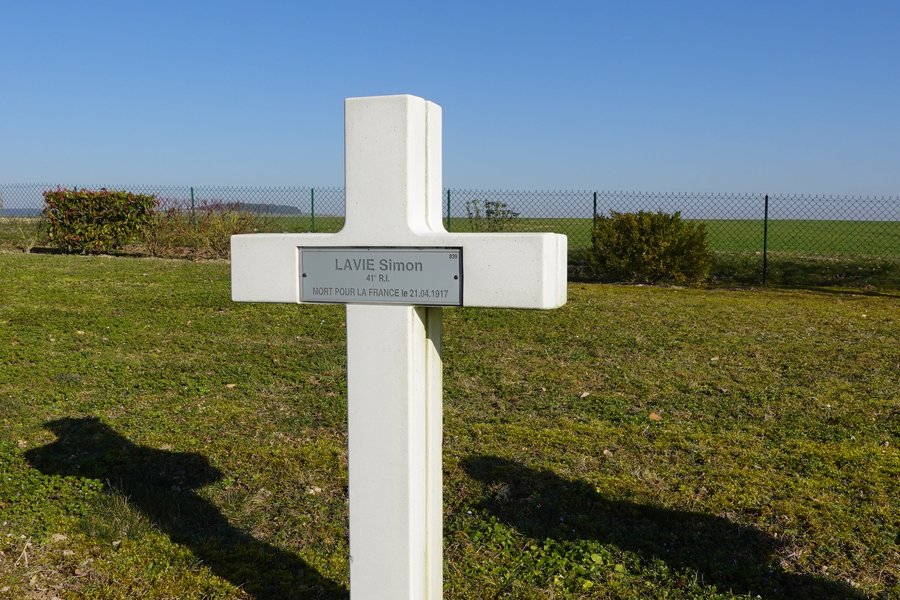
The transnational serial UNESCO World Heritage site "Memorial Sites of the First World War (Western Front)" is touchy. It could be the subject of controversy since it was inscribed on the list by the World Heritage Committee despite the ICOMOS advisory opinion being unfavourable considering that criterion (iii): bearing a unique or at least exceptional testimony to an existing or vanished cultural tradition or civilisation was not demonstrated and that the justification for criteria (iv): offering an eminent example of a type of construction or architectural or technological ensemble or landscape illustrating a significant period or periods in human history and (vi): being directly or tangibly associated with events or living traditions, ideas, beliefs or artistic and literary works of outstanding universal significance was too imprecise.
I will not enter here into the technical-political controversy concerning the opinion of ICOMOS and the choice of the World Heritage Committee; I will only give this column the point of view of the simple traveler-tourist with regard to criteria (iii), (iv) and (vi).
I had already visited Verdun several times during my childhood, my adolescence and then with my family: it was necessary for my children to become aware of what modern warfare is and its consequences. Previously, my wife and I had already visited some places on the site, taking advantage of one trip or another to the south.
For clarity, as there are 139 listed sites, which is a lot, I am using the UNESCO nomenclature to designate each …
Keep reading 0 commentsStanislaw Warwas
Funerary and memory sites of the First World War
Funerary and memory sites of the First World War (Inscribed)
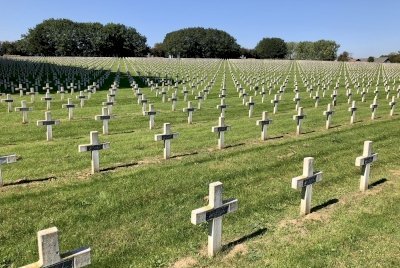
Visited September 2023
I know it means nothing and will change nothing, but I am against this kind of inscriptions! UNESCO is opening the door to any national or international conflict. Even if the monuments to the dead are of the highest artistic value, I cannot forget that they were constructed and built to commemorate also those who were killing, not only defending themselves – for me it is a shame that we make passed or recent wars something to appreciate – and UNESCO list should be made of sites that merit to be unique in a positive way… You can ask me: why you visit these cemeteries and monuments? I visit lots of places, these one amongst them. But not to make them something special, rather to remember that conflicts make conflicts and wars make wars. There are others who do not share my point of view and my point of feelings… For some of them to put something on a pedestal means fighting, fighting without any reflection… I do not even want to imagine that in some years (probably I will not be here anymore) UNESCO World Heritage List (Liste du Patrimoine Mondial de l’UNESCO) would be dotted with war graves and war symbols… Thousands of crosses (like on the picture) do not make me be proud of…
Keep reading 0 commentsClyde
Funerary and memory sites of the First World War
Funerary and memory sites of the First World War (Inscribed)
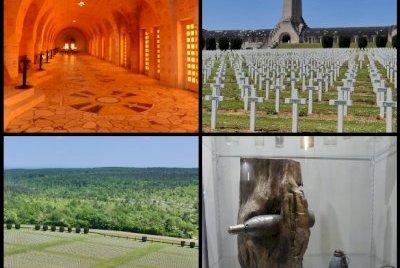
I visited several minor Belgian locations and cemeteries of this tWHS over the past years and in May 2023 I focused mainly on the French locations around the Ossuary of Douaumont. The latter visit fully convinced me that this tWHS truly possesses tangible OUV as the area around Verdun is basically one whole cultural/memorial landscape shaped by World War I.
The Douamont Ossuary is managed by a private foundation that clearly underlines that the site is "non-subsidised since 1919 although recognised as promoting the public interest". I tried to keep this in mind when paying the 7 euro ticket for a well-presented overview view video and the chance to visit the "cloister" and climb the 46 metre tower known as the Lantern of the Dead, which contains a 2 tonne bell which is struck at 12 and at 4pm. The tower is given this name as it partly lights the battlefield and the necropolis at night and the panoramic view of the cemetery from the top gives you a better idea of the sheer size and landscape shaped by war. On either side of the entrance to the tower, the 133 metre main gallery is home to 46 cenotaphs in 18 alcoves. These symbolic tomb stones cover spaces containing the remains found in various areas of the battlefield. Without paying for any ticket, these spaces and countless bones and skulls can be seen through the windows located at the rear of the monument. In the cloister, the names of …
Keep reading 0 commentsJakob F.
Funerary and memory sites of the First World War by Jakob Frenzel
Funerary and memory sites of the First World War (Inscribed)
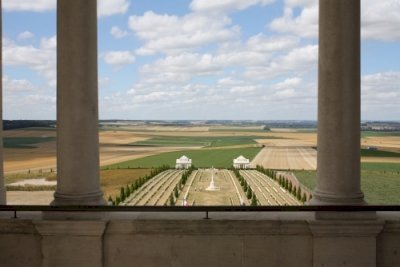
July/August 2018 - I learned quite intensively and detailed about the Grand Guerre. In German schools WW2 and the prior rise to power by the Nazis is extensively discussed, but without understanding the reasons and the effects of WW1 it doesnt really make sense.
With crossing of the border we arrived in the zone rouge. It is not only devistated by mining but also due to the war. North of Arras, we came through crater landscapes, where you can still see the trenches, were French/British troops were fighting the German troops. Quite impressive, that it has fomred this area so much. East of Amiens we visited the Australian cemetery (a frightning amount of graves) where you wonder why Australians, Arabs, Maoris, Chinese, and, and and were fighting for nonsense in European dexterity. We went further to Albert and the Lochnagar-Krater (dont understand why this is not on the tentative list). The touristic scope seems to be mostly on WWI in this area.
Towards the end of our roadtrip we crossed the region around Verdun. more than 1 million soldieres died here within one giant battle. There are many sites around here that shall be visited: Fort de Douaumont was already built before in preparation of a Franco-german war, but the most impressive, thoughtful places is the Douaumont Ossuary which holds the remains of 130000 unidentified soldiers.
WW1 is probably the most perverted event in history that evolved due to strengthening of nationalist ideas. It was the last …
Keep reading 0 commentsZoë Sheng
Funerary and memory sites of the First World War
Funerary and memory sites of the First World War (Inscribed)
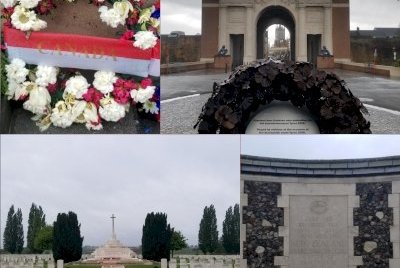
There is clearly an opposition to glorify war memorials by the advisory board and I used to agree until I visited the sites in Belgium and France to see the WWI funeral sites. These do not glorify the war at all. They instead remind us how countries bonded together to protect each other, something I don't see as black and white in today's political climate.
Right from the start these sites are pretty grim. They do not talk about “victory”, only about the losses of protecting Belgium and France. I am not going to go into the war details, that you can read up online of course, but it clear to me that these sites differ from any war memorial in the world's including Pearl Harbor, funeral sites in Turkey, Normandy beaches, countless others. The main difference is that these sites tend to show their own losses in war and how they won or suffered, not how the world came together to protect from “evil”.
The main highlights to visit are Tyne Cot cemetery and Menin Gate. Each doesn't take long to see but gave me lots to think about. If you can time your visit with an event at the gate you are even better off.
Keep reading 0 commentsnan
Funerary and memory sites of the First World War by Nan
Funerary and memory sites of the First World War (Inscribed)
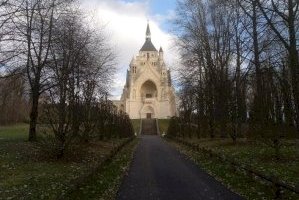
"You want to go where?" my aunt asked me. "La Grande Tombe de Villeroy, it's just next to Meaux, we can pass it on our way to the airport."
You need to know my mother's family is from Meaux, a town East of Paris. And indeed when coming from the East (Epernay) and heading to the world's worst airport (Charles de Gaulles), you pass within a few kilometers of the site.
My aunt asked again what precisely I wanted to see there. "A Nécropole, must a big thing" I said. Now my French is okay, but not perfect, so my aunt was trying to make sure she didn't misunderstand me. Eventually, she accepted that I meant the tomb. But she corrected me: "It's not a big thing, it's a small sign along the road." I couldn't quite fathom this information (Nécropole, Grande Tombe?), so I quickly googled the site and indeed: La Grande Tombe is pretty tiny. Most people in nearby Meaux wouldn't even know about it. But thanks to an inquisitive friend my aunt had been before and was able to counsel against a visit. Instead we stopped in Dormans on our way to the airport.
Dormans was my second site of the serial nomination. I had been to the cemetery in Arras just next to the Vauban fortification a year prior. In Arras you will find a simple toned down cemetery. Dormans is different, already signified by the address: Avenue des Victoires (Victory …
Keep reading 0 commentsThibault Magnien
Funerary and memory sites of the First World War
Funerary and memory sites of the First World War (Inscribed)
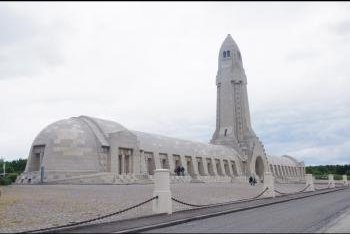
The sites related to WW1 are of great universal significance. The conflict had a huge impact not only for the people who were involved in it but also for all mankind. It took human people from the era of artisanal and local war to industrial and global war. The site also embodies the need, following the conflict, to honour and remember, on a large scale, those who fought and suffered. For the first time, anonymous fighters were honoured as much as famous heroes.
I have visited sites in Verdun, Somme, Chemin des Dames, Westhoek and other parts of Belgium. To me, the most striking testimony of the conflict is around Verdun. The whole landscape around the city has been modified by the conflict, from fully destroyed villages to forts, from forests in which traces of bombs are still visible to cemeteries.
Keep reading 0 commentsHubert
Funerary and memory sites of the First World War
Funerary and memory sites of the First World War (Inscribed)
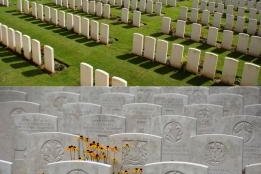
The cemeteries and memorials of World War I are on the list of missing sites on this website (no. 50), and I also voted for them. Back then my vote was based on information from articles and TV documentaries and on a visit to Verdun at the age of 16. In 2015, I had the opportunity to visit some of the proposed sites at two occasions: a revisit to Verdun in April and several sites near Reims and Amiens on our trip through northern France in September.
The French part of this transnational site comprises 80 elements evenly distributed along the line of the western front from the Belgian border to the Vosges. Actually the list is more than twice as long because a lot of the locations are further divided into sub-locations. The selection was made from more than a thousand potential sites and some principles are apparent: a) the geographical distribution, all regions along the course of the front are represented; b) the variety of sites: huge national memorials but also small monuments dedicated to individual persons or certain events; cemeteries of all sizes, some with only a few dozen graves and others with an inconceivable number; c) all involved nations are represented.
The commemoration of all victims is equal irrespective of nation, race, creed or military rank, the graves and engravings of names are uniform. But there are differences between the nations in the style of the cemeteries and graves. Certainly, the most striking difference …
Keep reading 0 commentsSolivagant
Funerary and memory sites of the First World War
Funerary and memory sites of the First World War (Inscribed)
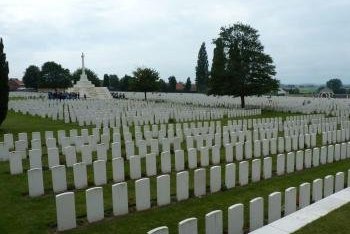
Our failure ever to visit the WWI sites of the Western Front had long been an “annoying” gap in our travel portfolio – especially as I had voted them for the “Top 50 Missing”! So rectifying this was one of the numerous objectives to be achieved whilst we were over for the 2015 WHS “get together”.
An immediate problem facing anyone wanting to see these sites is how to choose from among the many locations listed in the Belgian and French T List entries. Yes - it appears that (unlike the separate nearby Coal Mines inscriptions) this is to be a “transnational” nomination. It is interesting to note that Belgium was first into the field with its T List proposal “Lieux de memoire et monuments de la Grande Guerre: le Westhoek et Regions voisines” from as long ago as 2002. However, in 2014 France decided to get in on the act, and a newly titled combined entry appeared in each country’s T List. We spent a day visiting sites in both countries but I will limit this review to the Belgian side. I may review the French memorials later - for us this has been a year of “war memorials”, having visited Gallipoli also. I am still resolving my thoughts on the whole subject, on the differences in national approach and on the whole subject of their suitability as WHS.
People visiting these sites will have a vast range of reasons to for doing so - we met …
Keep reading 0 commentsAnonymous
Funerary and memory sites of the First World War
Funerary and memory sites of the First World War (Inscribed)
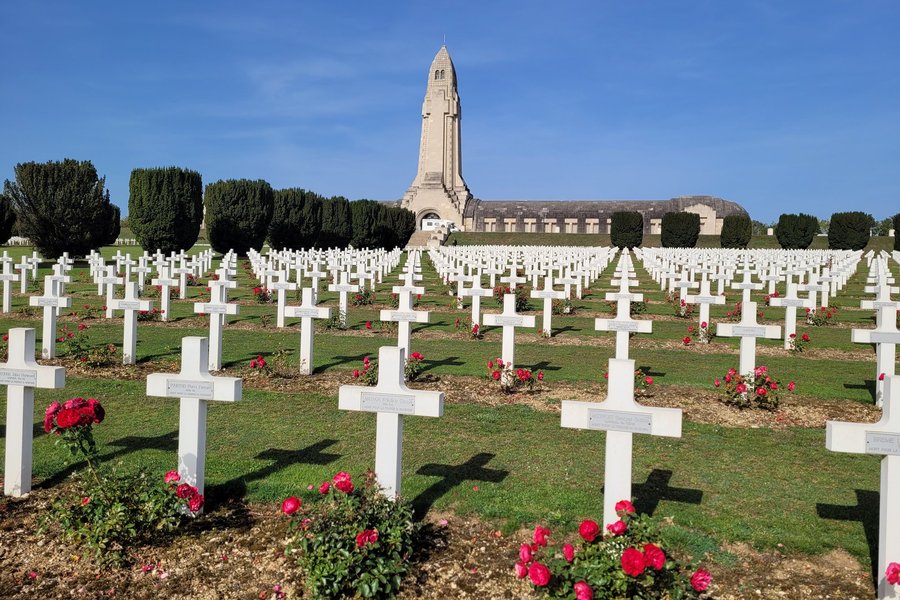
Im a 32 year old belgian, this review starts with a shame on me. Why? Well today i visited the Westhoek for the first time.
It was a beautiful sunny early autumn day so we wanted to visit the theme park Bellewaerde near Ypres. At arrival we saw that it was overcrowded so we decided to explore the region instead. Our tour brought us from one cemetery to the other. all as confronting as breathtaking. the amazing serenity, the perfect maintenance, the purity of every memorial, the multitude of origins of victims made us realize the global size of horror, trauma, tragedy millions of people from all around the world carried and are still carrying today. After visiting the trenches of Hill 61 and the small but very straight to the bone museum next to it, our feet were finally put in the middle of the reality of the Westhoek inhuman cruelty of 1914 till1918. This Iddillic scenery should not lose its historical importance and contrast.
You see here that people write long reviews. I don't think its because we like to write. I think its just because 'we have to' after visiting this most beautiful region with such a short but oh so important black chapter in history.
I love to travel and with great admiration I have visited many World Heritage Sites already in my life. But I live only 1h from the Westhoek, ignorant and naive. A Theme park with some rollercoasters with too long cues should …
Keep reading 0 commentsEls Slots
Funerary and memory sites of the First World War
Funerary and memory sites of the First World War (Inscribed)

I really became aware of this tentative WHS only after the favourable comments made at the 'Top 50 Missing'-topic at the Forum. World War I has largely passed by on the Netherlands and one seldom hears about it here. The first time I really was confronted with what this war meant was when I started studying History at University. There we had to watch the 1916 propagandafilm 'Battle of the Somme' with its graphic portrayal of trench warfare.
So I decided this was a tentative WHS surely to be visited and on a Sunday in June I drove 2,5 hours south to Ieper. The town itself has the usual Flemish charm. What's extra here are the numbers of English tourists and schoolgroups. I started my rounds at the In Flanders Fields-museum. It's a very visual museum with lots of photos, large objects and films. It also draws heavy on the participation of the 'World' in the 'World War'.
The Menin gate is the most important WWI monument in Ieper. It's a British war memorial to the 54.896 missing soldiers. Very impressive to find such a monument in such a small-sized town. I also drove to the British-Canadian Maple Copse cemetery, one of the many that are scattered among the farming fields.
In all, it's an important site to a large part of the world population, almost like a pilgrimage site nowadays. It would be a valuable addition to the List, one even wonders why it takes so long. Maybe it …
Keep reading 0 commentsIan Cade
Funerary and memory sites of the First World War
Funerary and memory sites of the First World War (Inscribed)
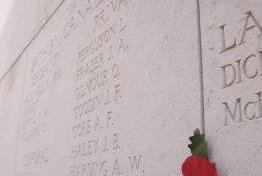
I have visited these sites on two separate occasions. The first time was on a school trip that visited many of the battlefields and memorials to the First World War (le Grande Guerre) in this region of Europe, this trip included visits to the sites across the boarder in France especially those connected with the battle of the Somme. I would hope that these monuments would be added to the Belgian entry.
The main memories I have are of the rows and rows of immaculately kept graves representing soldiers lost from all over the world. It is a sobering but magnificent site the sheer number of graves is incredible and the fact that they are still so magnificently looked after is a real credit to all involved. The prominence and importance of the sites are obviously derived from the large amounts of lives lost in the fields of this corner of Europe, however the exceptional plans and landscape design are also of significant note.
10 years after my initial visit I returned to the area to visit the Flemish city of Ieper (Ypres) which was almost totally destroyed in the first world war. There are memorials all around the city the most famous and stirring is the Menin gate where the last post bugle call is played every evening, it is a very sobering and sombre occasion but certainly worth witnessing. The Gate itself is covered with thousands of names of those that died fighting for the city and is …
Keep reading 0 comments
